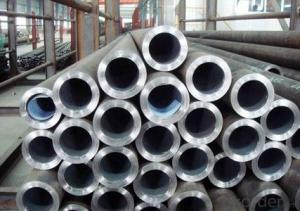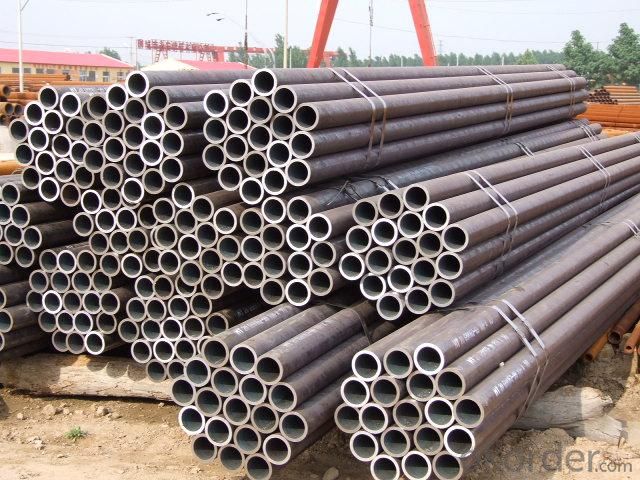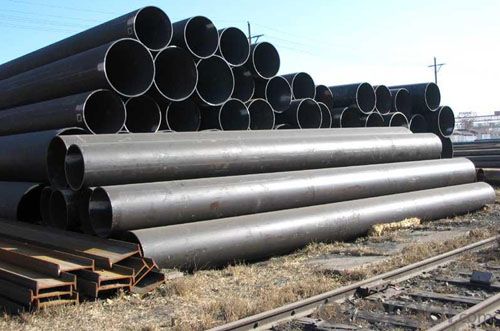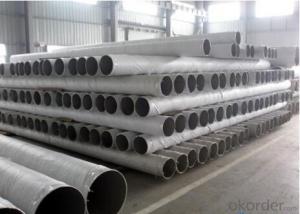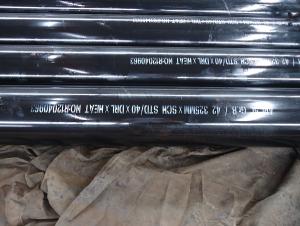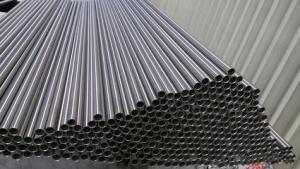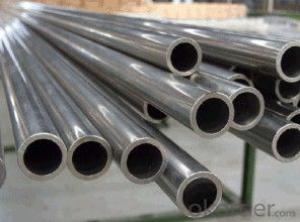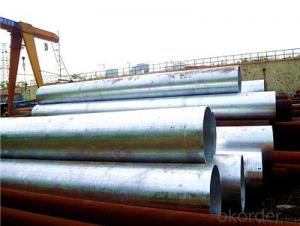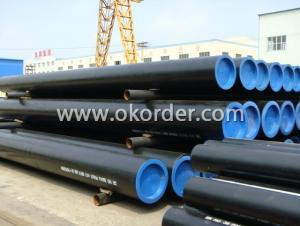CARBON SEAMLESS STEEL PIPE WITH GOOD QUALITY
- Loading Port:
- Tianjin
- Payment Terms:
- TT or LC
- Min Order Qty:
- 20 m.t.
- Supply Capability:
- 9000 m.t./month
OKorder Service Pledge
OKorder Financial Service
You Might Also Like
1、Structure of Seamless Pipe ASTM A106/53:
Seamless pipe is formed by drawing a solid billet over a piercing rod to create the hollow shell. As the manufacturing process does not include any welding, seamless pipes are perceived to be stronger and more reliable. Historically seamless pipe was regarded as withstanding pressure better than other types, and was often more easily available than welded pipe.
2、Main Features of the Seamless Pipe ASTM A106/53:
• High manufacturing accuracy
• High strength
• Small inertia resistance
• Strong heat dissipation ability
• Good visual effect
• Reasonable price
3、Seamless Pipe ASTM A106/53 Specification:
Production | ASTM A179 Gr.C seamless carbon steel pipe |
Standard | API 5L, ASME, ASTM, DIN, GB8162, GB8163, GB5310,etc. |
Out Diameter | 1/8"~16",10mm~406mm |
Wall Thickness | SCH5~SCH140,STD,XS,XXS,4mm~80mm |
Material | ASTM A106 GRB/ A53 GRB/ API 5L X42,X52,X60,X65,X70GRB/ API 5 CT/ ST42/ST37/ ST52.Q235/Q345/A179etc. |
Length | 1-12m or as customers required |
Surface treatment | Black painting, black varnish, transparent oil, epoxy coating, etc. |
Technique | Seamless |
Usage | 1. Low and middle pressure fluid transportation pipeline 2. Casing Tube 3. Boiler Pipe 4. Petroleum and natural gas industry 5. Chemistry industry 6. Electric industry |
Package | 1. Bundle packing. 2. Bevelled end or plain end or vainished as buyer's required. 3. Marking: as per customer's requests. 4. Painting varnish coating on the pipe. 5. Plastic caps at ends. |
Supply | 1. Seamless steel pipe 2. steel casing 3. tubing 4. hot-rolled steel pipe |
Min Order Quantity | According to customer's requirement |
Payment terms | L/C, T/T, Western Union,etc. |
What's the features of our products ?
1) Arts and crafts: cold-drawn or hot-rolled;
2) Surface Treatment: as customers' request
3) Chemical and Physical characteristic: durable, corrosion resistant and high-temperature resistant
4) We also produce pipes with special specifications according to customers’ requirements
4、Packaging & Delivery
Packaging Details: | seaworthy package,bundles wrapped with strong steel strip |
Delivery Detail: | 15-30days after received 30%TT |
5、FAQ of Seamless Pipe ASTM A106/53:
①How is the quality of your products?
Our products are manufactured strictly according to national and internaional standard, and we take a test
on every pipe before delivered out. If you want see our quality certifications and all kinds of testing report, please just ask us for it.
Guaranteed: If products’ quality don’t accord to discription as we give or the promise before you place order, we promise 100% refund.
②How about price?
Yes, we are factory and be able to give you lowest price below market one, and we have a policy that “ for saving time and absolutely honest business attitude, we quote as lowest as possible for any customer, and discount can be given according to quantity”,if you like bargain and factory price is not low enough as you think, just don’t waste your time.Please trust the quotation we would give you, it is professional one.
③Why should you chose us?
Chose happens because of quality, then price, We can give you both.Additionally, we can also offer professional products inquiry, products knowledge train(for agents), smooth goods delivery, exellent customer solution proposals.Our service formula: good quality+good price+good service=customer’s trust
SGS test is available, customer inspection before shipping is welcome, third party inspection is no problem.
6、Seamless Pipe ASTM A106/53 Images:

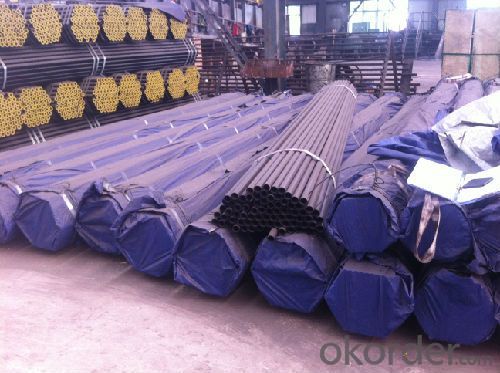
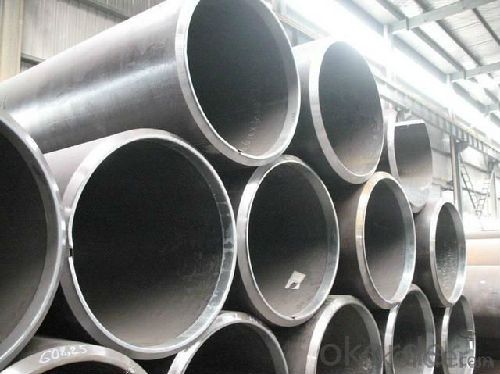
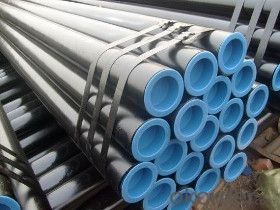
- Q: What is the difference between nominal and actual pipe size?
- The nominal pipe size refers to the approximate size of a pipe based on its interior diameter, while the actual pipe size refers to the precise measurement of the interior diameter.
- Q: Can steel pipes be used for gas distribution?
- Yes, steel pipes can be used for gas distribution. Steel pipes are commonly used in gas distribution systems due to their durability, strength, and resistance to corrosion. They can handle high-pressure gas transmission and are suitable for both underground and aboveground installations. However, certain safety regulations and standards must be followed to ensure the proper installation and maintenance of steel pipes for gas distribution.
- Q: What is the maximum length of steel pipes available in the market?
- The maximum length of steel pipes available in the market can vary depending on the specific supplier and industry requirements. However, standard lengths typically range from 20 to 40 feet.
- Q: How are steel pipes connected together?
- Steel pipes are typically connected together using various methods such as welding, threading, or using mechanical fittings, depending on the specific application and requirements.
- Q: What is the difference between standard wall thickness and extra-strong wall thickness steel pipes?
- The difference between standard wall thickness and extra-strong wall thickness steel pipes lies in the thickness of the pipe walls. Standard wall thickness pipes have a thinner wall compared to extra-strong wall thickness pipes, which have a thicker wall. The increased wall thickness in extra-strong pipes enhances their strength and durability, making them suitable for applications that require higher pressure or load-bearing capacities.
- Q: What are the challenges faced in transporting steel pipes?
- There are several challenges faced in transporting steel pipes. Firstly, their sheer weight and size make it difficult to handle and transport them. Specialized equipment and vehicles are required to lift and transport these heavy pipes safely. Secondly, steel pipes are susceptible to damage during transportation. They can get scratched, dented, or bent, which can compromise their structural integrity. Proper packaging and securement are crucial to prevent any damage during transit. Additionally, due to their length, steel pipes may exceed the legal limits for road transportation, requiring special permits and escorts. Lastly, ensuring timely delivery and coordination between multiple parties involved in the transportation process can be a logistical challenge.
- Q: Are steel pipes suitable for underground mining applications?
- Steel pipes are a great choice for underground mining. The mining industry has been using steel pipes for a long time, and they have many different uses, such as supplying water, providing ventilation, and moving materials. Steel pipes are strong and durable, making them perfect for the tough conditions of underground mining. One of the reasons steel pipes are so good for underground mining is their high tensile strength. This means they can handle the pressure and stress from the rock and earth around them. They can also carry heavy loads, which is important for transporting materials and supporting structures in mining tunnels. Another advantage of steel pipes is their resistance to corrosion. This is really important in underground mining, where there's often moisture and chemicals around. With steel pipes, you don't have to worry about them getting damaged and needing to be replaced or repaired all the time. Steel pipes are also easy to weld and join together. This means they can be customized to fit different shapes and sizes to suit the specific needs of each mining operation. To sum up, steel pipes are a fantastic choice for underground mining because they're strong, durable, resistant to corrosion, and versatile. They've been proven to be effective in supporting mining operations and ensuring safety and efficiency.
- Q: What is a steel pipe?
- A steel pipe is a cylindrical hollow tube made of steel, known for its strength and durability. It is commonly used in various industries for transporting fluids, gases, and solids, as well as for structural purposes in construction and infrastructure projects.
- Q: What are the factors to consider when selecting steel pipes?
- When selecting steel pipes, some of the key factors to consider include the intended use or application, the required strength and durability, the size and dimensions of the pipes, the corrosion resistance properties, the cost and availability, and any specific industry or regulatory requirements.
- Q: How are steel pipes used in the manufacturing of irrigation systems?
- Steel pipes are commonly used in the manufacturing of irrigation systems as they provide durability, strength, and resistance to corrosion. These pipes are used to connect various components of the irrigation system, such as pumps, filters, valves, and sprinklers. They ensure the efficient flow of water, withstand high pressure, and can be easily customized to fit the specific requirements of the irrigation system.
Send your message to us
CARBON SEAMLESS STEEL PIPE WITH GOOD QUALITY
- Loading Port:
- Tianjin
- Payment Terms:
- TT or LC
- Min Order Qty:
- 20 m.t.
- Supply Capability:
- 9000 m.t./month
OKorder Service Pledge
OKorder Financial Service
Similar products
Hot products
Hot Searches
Related keywords
